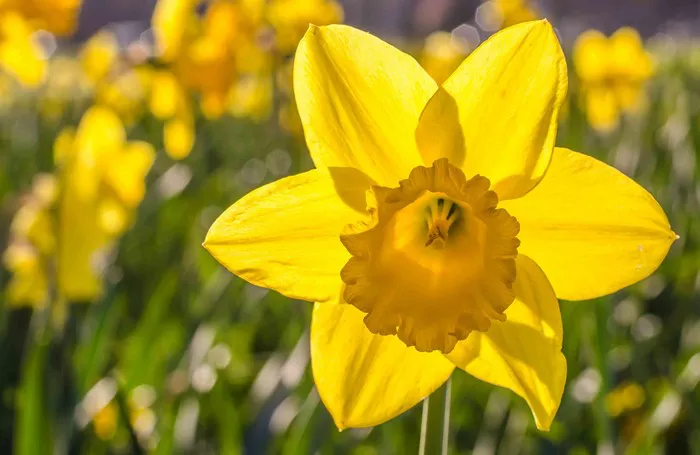Gardening enthusiasts often find themselves in a battle against groundhogs, those furry garden intruders notorious for munching on plants. While these creatures play a role in ecosystems, their voracious appetites can wreak havoc on carefully cultivated flower beds. Fortunately, there are several flowers that groundhogs tend to avoid, providing gardeners with options to protect their beloved blooms. In this comprehensive guide, we’ll explore a variety of flowers that are less appealing to groundhogs, helping you maintain a beautiful garden sanctuary.
Understanding Groundhog Behavior
Before delving into which flowers groundhogs avoid, it’s essential to understand their behavior and dietary preferences. Groundhogs, also known as woodchucks or whistle pigs, are herbivores that primarily feed on vegetation such as grasses, clover, fruits, vegetables, and certain flowers. They are particularly active during the spring and summer months when gardens are in full bloom, making them a significant concern for gardeners.
Groundhogs are attracted to gardens for their abundant food sources and sheltered environments. They are known for their burrowing habits, creating extensive underground tunnels and burrows for nesting and hibernation. While they may seem cute and harmless, their feeding habits can cause significant damage to gardens, leading many gardeners to seek effective deterrents.
Flowers Groundhogs Tend to Avoid
Daffodils (Narcissus spp.): Daffodils are known for their bright, trumpet-shaped flowers and are a staple in many gardens. Fortunately, they contain toxic alkaloids that make them unappealing to groundhogs. Planting daffodils around the perimeter of your garden can serve as a natural deterrent.
Alliums (Allium spp.): Alliums, which include varieties such as onions, garlic, and ornamental alliums, emit a pungent odor that groundhogs find repulsive. These plants contain sulfur compounds that give them their characteristic scent, effectively deterring groundhogs from feeding on nearby vegetation.
Lavender (Lavandula spp.): Lavender is prized for its fragrant blooms and versatile uses in gardens. Groundhogs are known to avoid plants with strong odors, making lavender an excellent choice for repelling them. Additionally, the fuzzy texture of lavender leaves can be unpleasant for groundhogs to consume.
Marigolds (Tagetes spp.): Marigolds are popular for their vibrant colors and ability to repel pests due to their strong scent. Groundhogs are less likely to feed on plants surrounded by marigolds, making them a valuable addition to garden borders and beds.
Sedum (Sedum spp.): Sedums, also known as stonecrops, are drought-tolerant succulents that produce clusters of colorful flowers. Their thick, fleshy leaves contain compounds that deter groundhogs, making them a low-maintenance option for gardens prone to groundhog activity.
Peony (Paeonia spp.): Peonies are prized for their large, showy flowers and lush foliage. While groundhogs may occasionally nibble on peony leaves, they generally avoid consuming them due to their bitter taste. Planting peonies in areas frequented by groundhogs can help protect more vulnerable plants.
Bee Balm (Monarda spp.): Bee balm, also known as bergamot or wild oregano, is valued for its aromatic foliage and attractive flowers. Groundhogs tend to avoid plants with strong odors, making bee balm an effective deterrent. Additionally, the tubular shape of bee balm flowers may be challenging for groundhogs to access.
Ferns (Various genera): Ferns are non-flowering plants prized for their lush, green foliage. While groundhogs may occasionally nibble on fern fronds, they generally prefer flowering plants. Incorporating ferns into garden landscapes can help diversify plantings and discourage groundhog activity.
Bleeding Heart (Dicentra spp.): Bleeding hearts are shade-loving perennials known for their unique heart-shaped flowers. While groundhogs may investigate bleeding heart plants out of curiosity, they typically avoid consuming them due to their toxic properties. Planting bleeding hearts in shaded areas can help protect them from groundhog damage.
Foxglove (Digitalis spp.): Foxglove is prized for its tall spikes of tubular flowers and ability to attract pollinators. However, it contains toxic compounds known as cardiac glycosides that make it unpalatable to groundhogs. Incorporating foxglove into garden designs can deter groundhogs while adding vertical interest.
Additional Strategies for Groundhog Control
While planting flowers that groundhogs tend to avoid can help protect your garden, it’s essential to employ additional strategies for effective groundhog control. Consider the following tips:
Fencing: Installing a sturdy fence around your garden can prevent groundhogs from gaining access. Use hardware cloth or chicken wire buried at least one foot underground to deter burrowing.
Repellents: Commercial repellents containing ingredients such as garlic, capsaicin, or predator urine can deter groundhogs from entering your garden. Apply repellents according to product instructions and reapply after rainfall.
Trapping and Removal: Live traps can be used to capture groundhogs for humane relocation. Check local regulations regarding trapping and release, and follow proper handling procedures to minimize stress to the animals.
Habitat Modification: Remove potential food sources such as fallen fruits and vegetables, and eliminate areas of dense vegetation where groundhogs may seek shelter. Keeping your garden tidy can make it less attractive to groundhogs.
Companion Planting: Intercropping flowers and vegetables with plants that repel groundhogs can provide additional protection. For example, planting squash or cucumbers near marigolds may help deter groundhogs from feeding on vulnerable crops.
By incorporating a combination of these strategies and selecting flowers that groundhogs tend to avoid, you can create a garden oasis that is less susceptible to damage. Remember to monitor your garden regularly for signs of groundhog activity and adjust your approach as needed. With patience and persistence, you can enjoy a flourishing garden free from groundhog interference.
Conclusion
Protecting your garden from groundhog damage requires a multifaceted approach that includes both proactive measures and strategic plant selection. By choosing flowers that groundhogs tend to avoid and implementing additional deterrents such as fencing, repellents, and habitat modification, you can minimize the impact of groundhog activity on your garden. With careful planning and consistent maintenance, you can create a beautiful outdoor space that brings joy and tranquility for years to come.


